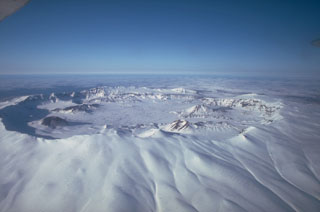Report on Okmok (United States) — February 1997
Bulletin of the Global Volcanism Network, vol. 22, no. 2 (February 1997)
Managing Editor: Richard Wunderman.
Okmok (United States) Cone on S side of caldera floor continues to emit lava, steam, and ash
Please cite this report as:
Global Volcanism Program, 1997. Report on Okmok (United States) (Wunderman, R., ed.). Bulletin of the Global Volcanism Network, 22:2. Smithsonian Institution. https://doi.org/10.5479/si.GVP.BGVN199702-311290
Okmok
United States
53.43°N, 168.13°W; summit elev. 1073 m
All times are local (unless otherwise noted)
The eruption that began 13 February continued between 28 February and 21 March. The cone on the south side of the caldera floor continued to emit lava and intermittent steam and ash plumes. Fort Glenn residents who climbed to the rim of the caldera saw a lava flow that was <500 m in length. On 19 February, ash fell on the flanks of the volcano associated with one of the larger steam-and-ash plumes. The largest plume during this period occurred on 11 March; a pilot noted a short-lived steam and ash plume that reached ~10.5 km and drifted NW.
Satellite imagery during this period revealed significant hot spots in the caldera and showed occasional plumes drifting as far as 85 km downwind.
Geological Summary. The broad, basaltic Okmok shield volcano, which forms the NE end of Umnak Island, has a dramatically different profile than most other Aleutian volcanoes. The summit of the low, 35-km-wide volcano is cut by two overlapping 10-km-wide calderas formed during eruptions about 12,000 and 2050 years ago that produced dacitic pyroclastic flows that reached the coast. More than 60 tephra layers from Okmok have been found overlying the 12,000-year-old caldera-forming tephra layer. Numerous satellitic cones and lava domes dot the flanks of the volcano down to the coast, including 1253-m Mount Tulik on the SE flank, which is almost 200 m higher than the caldera rim. Some of the post-caldera cones show evidence of wave-cut lake terraces; the more recent cones, some of which have been active historically, were formed after the caldera lake, once 150 m deep, disappeared. Hot springs and fumaroles are found within the caldera. Historical eruptions have occurred since 1805 from cinder cones within the caldera.
Information Contacts: Tom Miller, Alaska Volcano Observatory (AVO); NOAA/NESDIS Satellite Analysis Branch (SAB).

